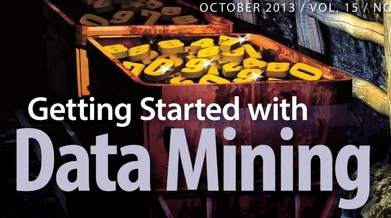| Data Mining Explored In SQL Server Pro Magazine |
| Written by Ian Stirk |
| Tuesday, 08 October 2013 |
|
How do you get started in Data Mining? The lead feature in the October 2013 issue of SQL Server Pro has everything you need to know with detailed step-by-step examples. In this overview of the online subscription-based monthly magazine, the items in bold below correspond to the name of the article in the current issue.
If you're new to Data Mining, or interested in the latest features, check out Getting Started with Data Mining in SQL Server. It's a massive 27-page article, which introduces the background of data mining (limits, architecture, tools), together with some great examples. The examples, which pertain to:
are detailed, with plenty of screen shots (21 in total) to accompany the text. You're encouraged to follow along with the step-by-step instructions within each example. The end result is a well thought out introductory article.
Additionally, variations in the pivot query (i.e. use of aliases and ORDER BY) are explained. The article should give you confidence in using what can be an intimidating feature. The corruption series continues with SQL Server Database Corruption, Part III: Preventing Corruption. In reality, corruption cannot be prevented, however it can be planned for and mitigated. You should aim to get notified of any corruption as soon as possible (this is discussed in the next article in the series). Having been notified of the corruption, you will want to restore a viable and tested backup to correct the corruption. For me, this is a very useful series of articles. Although corruption is a relatively rare event, when it occurs it can be a very stressful experience. Having a tested and planned approach should help ease this stress. I do wonder if this series might have been better as a single longer article. The series on Intervals and Counts continues, with 18 pages of largely code-led discussion. This article expands on last month's examples, discussing how performance can be improved by using the APPLY operator. Also discussed is computing counts during discrete intervals including packing logic. This month's editorial asks Does the Client Even Matter? Increasingly users want to use their own devices to access corporate data, this has led to the growth of Bring Your Own Device (BYOD). This can mean problems for IT infrastructure due to the number of disparate devices that need to be supported. It is suggested these clients will be drivers for new approaches and applications in the future. I can see parallels here with the problems and opportunities that occurred with the introduction of PCs into the mainframe-centric world of the early 1990s. The recent uncomfortable disclosures around the NSA and PRISM have brought security to the forefront of public awareness. With this in mind, there is a timely Transparent Data Encryption FAQs. The article answers questions such as:
There are some useful links for obtaining further information. Remember too that other encryption/security options exist (e.g. Column-level encryption, encryption using the .NET framework, and encrypting the File System). My favourite article was the one about database corruption. I've been in situations where the database was corrupt and there is no viable backup to restore (luckily, the corruption related to a non-clustered index which could easily be rebuilt). I guess this experience makes me appreciate the value of preventative measures. As often happens with this magazine, if your interests match to one of the lengthy feature articles, you will certainly be rewarded. I do question the size of some of the articles, maybe the space could be better used with shorter more numerous articles – but arguments could be advanced for both approaches. Luckily the spread of articles is wide enough so that everyone should find something of interest. More InformationRelated ArticlesLooking Forward to SQL Server 2014 (September Issue) SQL Server Pro's Tips For Performance Tuning and T-SQL (August issue) PowerShell The SQL Server Way (July issue) T-SQL Join Types In SQL Server Pro's June Issue Inside SQL Server Pro Magazine May 2013
To be informed about new articles on I Programmer, install the I Programmer Toolbar, subscribe to the RSS feed, follow us on, Twitter, Facebook, Google+ or Linkedin, or sign up for our weekly newsletter.
Comments
or email your comment to: comments@i-programmer.info
|
| Last Updated ( Tuesday, 08 October 2013 ) |


